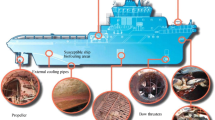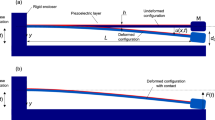Abstract
Bio-mimetic robots can provide better camouflage effect to explore the seabed by mimicking the swimming locomotion of aquatic creatures. Jellyfish-like robot is a type of unmanned underwater robot can help us explore marine ecosystems and complex underwater ecology efficiently since they can swim steadily with its symmetrical structure that has been optimized in nature and generate sufficient jet propulsion with low power input. The developed jellyfish robot in this paper exhibits contracting muscle-like behaviour. It combines a dielectric elastomer (DE) diaphragm actuator with a transmission mechanism, which can provide compliant thrust force to propel the jellyfish robot to transit through water. This paper presents the design, fabrication, modeling, and experimental characterization of the novel jellyfish robot. A sawtooth signal with specific amplitude and frequency is chosen as input signal that leads to expansion and shrinking of the jellyfish bell. The simulation results from the observed two steps in a cycle of movement are quantitatively similar with the experimental outputs. A data-driven model is developed to capture the vibration in the first step. The process of contracting the bell and producing thrust force is captured by a physical model in the second step. The preliminary results show the jellyfish robot can swim underwater effectively in the vertical direction. The average speed of the robot is about 5 mm/s when a sawtooth signal with 5 kV amplitude and 2 Hz frequency is applied to the DE actuator.



















Similar content being viewed by others
References
Cheng, T., Li, G., Liang, Y., Zhang, M., Liu, B., Wong, T.W., Forman, J., Chen, M., Wang, G., Tao, Y., Li, T.: Untethered soft robotic jellyfish. Smart Mater. Struct. 28, 11 (2018)
Christianson, C., Bayag, C., Li, G., Jadhav, S., Giri, A., Agba, C., Li, T., Tolley, M.: Jellyfish-inspired soft robot driven by fluid electrode dielectric organic robotic actuators. Front. Robot. AI 6, 126 (2019)
Colin, S., Costello, J.: Morphology, swimming performance and propulsive mode of six co-occurring hydromedusae. J. Exp. Biol. 205, 427–437 (2002)
Frame, J., Lopez, N., Curet, O., Engeberg, E.: Thrust force characterization of free swimming soft robotic jellyfish. Bioinspir. Biomimet. 13, 064001 (2018)
Gemmell, B., Troolin, D., Costello, J., Colin, S., Satterlie, R.: Control of vortex rings for manoeuvrability. J. R. Soc. Interface 12, 07 (2015)
Gemmell, B., Colin, S., Costello, J., Dabiri, J.: Suction-based propulsion as a basis for efficient animal swimming. Nat. Commun. 6, 11 (2015)
Gemmell, B., Du Clos, K., Colin, S., Sutherland, K., Costello, J.: The most efficient metazoan swimmer creates a virtual wall to enhance performance. Proc. R. Soc. B Biol. Sci. 288, 20202494 (2021)
Hareesh, G., Li, J., Wang, Y., Zhu, J.: A soft jellyfish robot driven by a dielectric elastomer actuator. IEEE Robot. Autom. Lett. 1, 1 (2016)
He, T., Cui, L., Chen, C., Suo, Z.: Large deformation analysis of a dielectric elastomer membrane-spring system. Smart Mater. Struct. 19, 085017 (2010)
Hodgins, M., York, A., Seelecke, S.: Experimental comparison of bias elements for out-of-plane deap actuator system. Smart Mater. Struct. 22, 094016 (2013)
Hodgins, M., Rizzello, G., Naso, D., York, A., Seelecke, S.: An electro-mechanically coupled model for the dynamic behavior of a dielectric electro-active polymer actuator. Smart Mater. Struct. 23, 104006 (2014)
Hoffstadt, T., Maas, J.: Adaptive sliding mode impedance and position control for dielectric elastomer transducers. In: Proceedings of the SPIE Conference on Electroactive Polymer Actuators and Devices (EAPAD), p. 105940Y (2018)
Kim, D., Shin, J.-U., Kim, H., Lee, D., Lee, S.-M., Myung, H.: Presented at the (2012)
Ko, Y., Na, S., Lee, Y., Cha, K., Ko, S.Y., Park, J.-O., Park, S.: A jellyfish like swimming mini robot actuated by an electromagnetic actuation system. Smart Mater. Struct. 21, 057001 (2012)
Maffli, L., Rosset, S., Ghilardi, M., Carpi, F., Shea, H.: Ultrafast all polymer electrically tunable silicone lenses. Adv. Funct. Mater. 25, 03 (2015)
Marut, K., Stewart, C., Michael, T., Villanueva, A., Priya, S.: A jellyfish inspired jet propulsion robot actuated by an iris mechanism. Smart Mater. Struct. 22, 094021 (2013)
Najem, J., Sarles, A., Akle, B., Leo, D.: Biomimetic jellyfish-inspired underwater vehicle actuated by ionic polymer metal composite actuators. Smart Mater. Struct. 21, 09 (2012)
O’Brien, B., Thode, J., Anderson, I., Calius, E., Hämmerle, E., Xie, S.: Integrated extension sensor based on resistance and voltage measurement for a dielectric elastomer. In: Proceedings of SPIE - The International Society for Optical Engineering (2007)
Plante, J.-S., Dubowsky, S.: Large-scale failure modes of dielectric elastomer actuators. Int. J. Solids Struct. 43, 04 (2006)
Rizzello, G., Naso, D., York, A., Seelecke, S.: Closed loop control of dielectric elastomer actuators based on self-sensing displacement feedback. Smart Mater. Struct. 25, 035034 (2016)
Shahinpoor, M., Kim, K.: The effect of surface-electrode resistance on the performance of ionic polymer-metal composite (ipmc) artificial muscles. Smart Mater. Struct. 9, 543 (2000)
Shi, L., Guo, S., Asaka, K.: A novel butterfly-inspired underwater microrobot with pectoral fins. In: 2011 IEEE International Conference on Mechatronics and Automation, ICMA 2011 (2011)
Shi, L., Guo, S., Asaka, K.: Development of a new jellyfish-type underwater microrobot. I. J. Robot. Autom. 26, 01 (2011)
Shintake, J., Shea, H., Floreano, D.: Biomimetic underwater robots based on dielectric elastomer actuators. In: Proceedings of 2016 IEEE/RSJ International Conference on Intelligent Robots and Systems, pp. 4957–4962 (2016)
Takemura, R., Akiyama, Y., Hoshino, T., Morishima, K.: Chemical switching of jellyfish-shaped micro robot consisting only of cardiomyocyte gel. In: 2011 16th International Solid-State Sensors, Actuators and Microsystems Conference, TRANSDUCERS’11, pp. 2442–2445 (2011)
Wang, S., Kaaya, T., Chen, Z.: Self-sensing of dielectric elastomer tubular actuator with feedback control validation. Smart Mater. Struct. 05,(2020)
Ye, Z., Chen, Z.: Self-sensing of dielectric elastomer actuator enhanced by artificial neural network. Smart Mater. Struct. 26, 07 (2017)
Yeom, S.-W., Oh, I.-K.: A biomimetic jellyfish robot based on ionic polymer metal composite actuators. Smart Mater. Struct. 18, 085002 (2009)
Zhou, Y., Jin, H., Liu, C., Dong, E., Xu, M., Yang, J.: Presented at the (2016)
Acknowledgements
This work was supported by the National Science Foundation under Grant CMMI #1747855.
Author information
Authors and Affiliations
Corresponding author
Additional information
Publisher's Note
Springer Nature remains neutral with regard to jurisdictional claims in published maps and institutional affiliations.
Rights and permissions
About this article
Cite this article
Wang, S., Chen, Z. Modeling of jellyfish-inspired robot enabled by dielectric elastomer. Int J Intell Robot Appl 5, 287–299 (2021). https://doi.org/10.1007/s41315-021-00192-1
Received:
Accepted:
Published:
Issue Date:
DOI: https://doi.org/10.1007/s41315-021-00192-1




